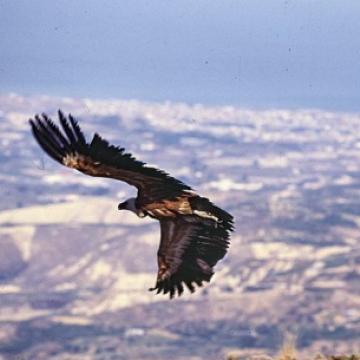GR4310002 - GIOUCHTAS - FARANGI AGIAS EIRINIS
Map
Quality
The site is characterized by high biodiversity and by the presence of many Cretan and Greek endemic species of flora and fauna. It is an ecological island surrounded by extensive cultivation, mainly vineyards and olive groves. Giouchtas mountain is one of EU's Important Bird Areas due to the presence of an important vulture colony. It is protected as an "important archaeological site" and as a "site of special natural beauty". However, legislation and protection are not effective. NOTE: Rhinolophus ferrumequinum ssp. creticum, a subspecies endemic to Crete, is included in section 3.2.c. as Rhinolophus ferrum-equinum.
Other characteristics
The southern part of the site is a rocky mountain with very steep slopes. The main rock is limestone of the Tripoli series. It is surrounded by extensive cultivation with vineyards and olivetrees. It is a very important archaeological site. Human activities have not stopped there since the early Neolithic times. The dominant vegetation is maquis and phrygana, but artificial pine and cypress groves. There are a T.V. transmitor and a church on the two highest peaks. The north-east and the north parts of the site comprise an intermittently flowing river with rich riparian vegetation. There is a small canyon at the north-east edge of the mountain. The rocks are neogene marbles.
Documentation
1) Legakis A. 1990. Study of the ecological management of Giouchtas mountain. Gathering analysis of data. Report.
University of Crete, Iraklion, p. 35 (3.1., 3.3., 4.1., 4.2., 4.3.)
2) Paragamian, K. 1992. The natural environment of Giouchtas mountain. Booklet, p. 16 (4.2., 4.3.)
3) Peraki S. 1992. Study of the protection management and development of Giouchtas mountain. Report, p. 50. (3.1., 4.4.)
4) Sowing. 1985. Beitrage zur Kenntnis der Verbreitung und Oekologie der Amphibien und Reptilien Kretas. Salamandra, 21(4): 252-262 (3.2.)
5) Turland N.L., Chilton & J. Press. 1993. Flora of the Cretan area. Annotated checklist & atlas. Natural History Museum, London, p.
439. (3.3.)
6) Database CORINE-MEDSPA
7) Georghiou K. 1995. Checklist of Endemic, Rare and Threatened Plants of Greece. Draft. University of Athens. (3.3, 3.4, 4.2)
8) Morgan V & C. Leon. 1992. Datasheets of Flora species for revision of Appendix I of the Bern Convention. Volume IV. endemic taxa of Cyprus, Greece and Turkey Nature and environment. Nature and Envrionment. No 63 p. 106. Council of Europe, Publishing and Documentaion Service, Strasbourg. (3.2.g.)
9) Boyec P. & K. Athanasiou. 1991. A new subspecies of Biarum tenuifolium (Araceae) from Crete. Flora Med. 1:5-13. (3.4)
10) Grimmet R.F.A. & T.A. Jones. 1989. The Important Bird Areas in Europe. ICBP Technical Publication No. 9, p. 906. (3.2. a).
11) [CORINE BIOTOPES] (3.2. a, b).
Reference: Natura 2000 data form, database release 7 Feb 2014




